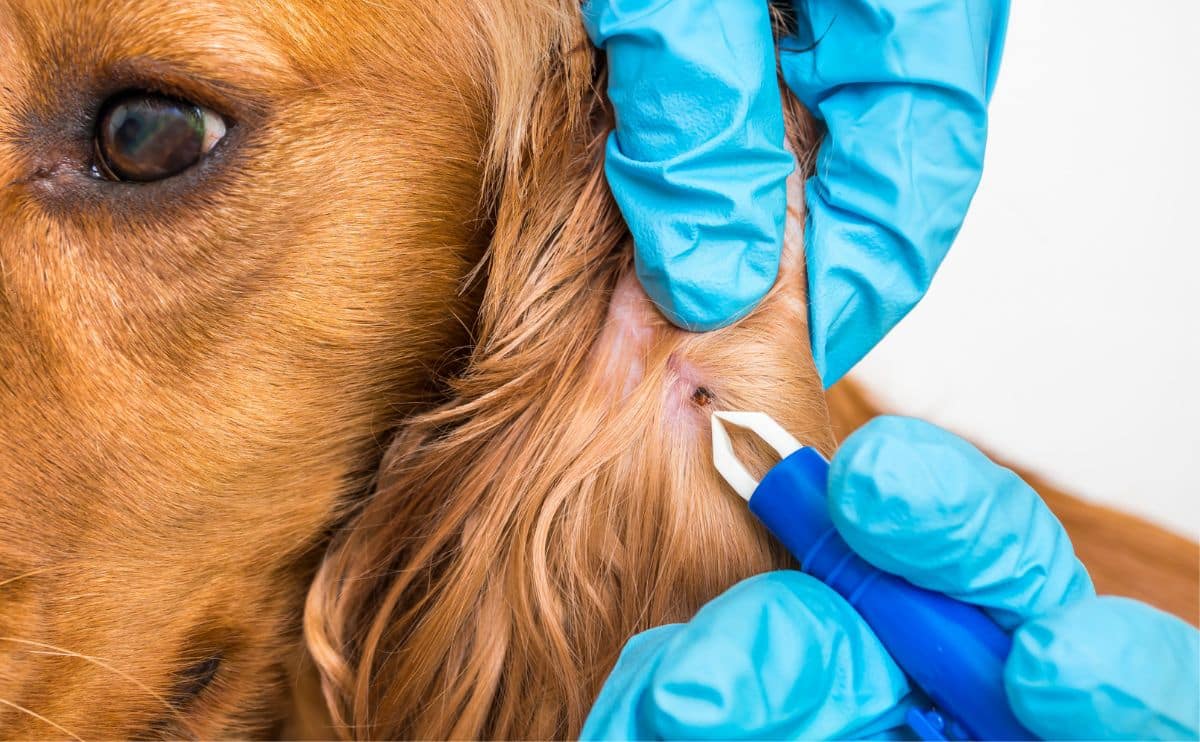This content was reviewed by veterinarian Dr. JoAnna Pendergrass, DVM.
When you purchase through links on our site, we may earn a commission. Here’s how it works.

As dog owners, we all have to deal with cruddy critters, and ticks on dogs are unfortunate but common occurrences. Experts say you should remove ticks on your dog as soon as you spot them to reduce the chance of disease. I’ll tell you how to safely remove a tick from a dog and give you tips on disease symptoms to watch out for, how to prevent ticks, and more.
“Many people search the internet for ways to remove a tick. This can be dangerous, as many methods are not safe,” says Dr. Joanna Woodnutt, MRCVS. “Agitating the tick can make them vomit, which makes it far more likely that they’ll spread disease to your pet. This is the safest way to remove a tick to reduce the chance of them spreading disease.”
- How To Remove A Tick From A Dog
- Don'ts With Tick Removal
- How To Remove A Tick Head From A Dog
- What Do I Do After Removing A Tick?
- What Do Ticks Do To Dogs?
- How Do Dogs Get Ticks?
- What Does A Tick Look Like On A Dog?
- How To Check Your Dog For Ticks (A Vet's Advice)
- Frequently Asked Questions
- Tick Prevention
- Why Trust Canine Journal?
How To Remove A Tick From A Dog

The best way to remove a tick from a dog is to use needle-nose tweezers or a tick removal tool like the Tick Twister. Here are the steps to remove a tick safely from your dog.
Tip: Most household tweezers have wide, blunt tips that could end up squeezing or tearing the tick and risk spreading infectious substances into the bite wound. So make sure to use fine-point tweezers.
- Spread your dog’s fur away from the tick
- Grasp the tick as close to the skin as possible, being careful not to squeeze the tick so hard that you break off the barbed mouth of the tick
- With firm pressure, gently pull straight upward in a slow, steady motion
- Place the tick in isopropyl alcohol to kill it
- Wash your hands thoroughly
- Clean the bite site with isopropyl alcohol
- Clean your tweezers or tool with alcohol
- Make a note of the bite date and the appearance of the tick (in case your dog develops any disease symptoms, this can be helpful for your veterinarian)
Our Personal Experience Removing Ticks From Dogs
I have completed regular pet first aid courses as a professional dog walker and sitter. The most common first aid incident I’ve had to deal with is the removal of ticks. Whether your pooch is a tick magnet or has never had one, I think all dog owners should own a tick-removing tool. I always carry one along with rubbing gel in my pet first-aid kit.
As long as the pup in question sits still, it’s simple to remove a tick. Spread the fur, use a proper tick-removing tool, and follow the instructions. Removing a tick from a wriggly dog can be tricky. But in my experience, most dogs settle for a tasty treat. They must be relaxed so you can remove the tick properly. If they’re too excited, wait for a calmer moment to remove the tick as soon as you can.
Before I covered tick removal in my first aid course, I was nervous about removing them. I was worried about leaving the head in the skin, not realizing, and the dog falling ill. But I’ve removed them from Dachshunds, Leonburgers, Collies, and more, and it’s always been a simple task.
–Emma Braby, professional dog walker and owner & Canine Journal writer
Watch A Vet Remove A Tick With A Twisting Tool
Don’ts With Tick Removal
Are you wondering how to remove a tick from a dog without tweezers or another dog tick-removal tool? Although you may hear about some other methods, they’re not recommended and can actually be harmful to your dog.
Some people claim that smothering the embedded tick with petroleum jelly (like Vaseline), rubbing alcohol, or essential oils will make the tick back out of your dog’s skin. This is a myth, and experts warn against these methods. While “drowning” the tick could help remove the tick’s body, the barbed mouth may stay embedded in your dog.
Some experts even say using petroleum jelly and other smothering agents can cause the tick to secrete infectious substances from its gut into your dog.
How To Remove A Tick Head From A Dog

What do you do if the tick’s “head” gets stuck in your dog after you remove the body? While the eye and mouth area resembles an insect head, ticks do not technically have heads.
But if a portion of the tick remains after removing most of it, this is likely the barbed mouth. Experts say not to remove it yourself. Digging around in your dog’s skin can increase the risk of a skin infection (and it’s unpleasant for your pup).
Instead, it’s best to let your dog’s body naturally expel or dissolve the tick “head.” Once most of the tick’s body is gone, the risk of infection from a tick-borne disease is low. If you want to take an extra measure, you can apply an antibiotic ointment to the site, just in case.
What Do I Do After Removing A Tick?
After tick removal, keep an eye on your dog to make sure he’s not showing any symptoms of a tick-borne disease. Depending on the disease, symptoms could appear within a few days or take up to weeks or months to appear.
Symptoms to watch out for also depend on the disease, but here are some general tick-borne disease signs. If you notice any of these signs, be sure to consult with a veterinarian as soon as possible.
- Fever
- Fatigue
- Loss of appetite
- Joint pain or swollen joints
- Swollen lymph nodes
- Vomiting
- Diarrhea
- Seizures (in rare cases)
When you talk with your vet, mention that you removed a tick from your dog. Your vet might want to see what the tick looks like to determine the type of tick and what disease it might have transmitted to your dog.
What Do Ticks Do To Dogs?
Ticks carry various infectious organisms that infect thousands of pets, people, and other animals every year. The most prevalent tick-borne diseases that affect dogs are Lyme disease, Ehrlichiosis, Rocky Mountain Spotted Fever, Anaplasmosis, Babesiosis, Bartonellosis, and Hepatozoonosis. All of these can make your dog sick.
Some of these infectious illnesses can easily spread to humans and other pets if they are bitten by a tick. Lyme disease is a big concern, especially because symptoms and side effects can last for months.
Further, your dog could carry a tick that contains the Powassan virus, which is often fatal in humans.
Once a tick bites its victim, it can transmit diseases as soon as three to six hours. So, checking for ticks regularly and removing them as soon as possible can help reduce the chance that your dog will become ill.
How Do Dogs Get Ticks?
Where do ticks come from, and how do dogs get them? There are hundreds of tick species worldwide; however, a small percentage actually bite and infect dogs and people. The most common tick species that affect dogs in the U.S. are the American dog tick, the deer or black-legged tick, the brown dog tick, and the lone star tick.
Ticks can live hardily in many different environments — woods, lawns, beach grass, and even urban areas. Ticks can fall from trees or bushes onto your dog or simply crawl onto your dog from grass. They may crawl around on your dog for a while before burrowing their mouths into the skin to feed on your dog’s blood.
What Does A Tick Look Like On A Dog?

Ticks are arachnids and resemble small spiders with eight legs and no antennae. They can be black, brown, or tan. Adult ticks range in size from 1mm to 1cm, depending on the type of tick. Ticks in the early developmental larvae and nymph stages are smaller, ranging from 0.5mm to 1mm (larvae and nymphs also embed and feed). Embedded ticks on dogs often swell up as they feed. Fully engorged adult ticks can balloon up to 2/3 of an inch in diameter.
You may be wondering, “What does an embedded tick look like on a dog?” When they’re embedded, the legs and body protrude out of your dog’s skin, so they appear and feel like an external bump (similar to a skin tag).
How To Check Your Dog For Ticks (A Vet’s Advice)
“It’s usually far easier to feel a tick than to see one. You can check for ticks by running your hands through your pet’s fur, feeling with your fingertips,” says Woodnutt. “Inspect any small bumps closely by parting the fur. In dogs, the best places to check are behind the ears, through the fur of the neck, in the skin folds of the armpit and groin, and between the toes. In cats, ticks tend to gravitate towards the back but can also be found around the head and neck. You should also check the ear flaps and just inside the ear, as some ticks prefer to attach here.”
Check your pup for ticks every day, especially after spending time outdoors. Ticks are hardy and can live in cold temperatures, so it’s vital to check year-round. Ticks prefer to attach themselves to areas around a dog’s head, neck, ears, paws, armpits, and groin area, but you can find them anywhere on a dog’s body.
Run your fingers through your dog’s fur with gentle pressure to feel for any small bumps, paying particular attention to the areas we mentioned above. Also, make sure you check inside your dog’s ears, on eyelids, under the collar, and between claws.
Frequently Asked Questions
Here are some of the questions our readers ask most often about ticks on dogs. If I missed yours, let me know in the comments.
Should I Try An Alternative Tick Removal Method Like Dental Floss?
No. You should not try any alternative tick removal method. Some people say they have used dental floss, but it is not recommended. While floss can remove a tick sometimes, it often presses into the tick, breaking it in half and leaving some embedded in your pup. Alternative methods rarely work and often make the situation worse. It’s worth the effort to get the proper removal tools.
How Long Do Ticks Stay On Dogs?
If you don’t find ticks on your dog and remove them, they usually stay until they finish feeding and drop off on their own. Feeding usually lasts several days but can last up to two weeks.
What Does A Tick Bite Look Like On A Dog?
Once ticks detach (or after you remove them), they often leave a small red bump that resembles a mosquito bite. However, tick bites aren’t always easy to spot, particularly on dark-haired or thick-coated dogs. These bumps usually resolve themselves over a few days.
What Happens If A Dog Eats A Tick?
Tick bites itch, so your dog could accidentally eat a tick if he’s chewing in the area. But don’t worry. If your dog eats a tick, he may vomit, but he won’t become infected with a tick-borne illness. The stomach lining will help protect your pup.
What If I Find A Dried Dead Tick On My Dog?
If the dried dead tick on your dog is still embedded, follow the removal steps above. Unfortunately, a dead tick can still transmit diseases, so remove it as soon as you discover it.
How Common Are Ticks On Pets?
According to Woodnutt, “A number of studies have shown that there’s been an increase in the abundance of ticks in recent decades. In addition, ticks appear to be spreading out from their traditional geographical areas, especially toward the north. It’s assumed that this is due to climate change. Still, it’s possible that other things (like deer farming, increased movement of animals, and changes in habitat management) could be contributing, too.”
“Unfortunately, good studies looking at historical tick bite frequency are unavailable, so it’s hard to track whether tick attachments have increased. We’re also becoming more aware of the implications of tick infestation, so we might be spotting and reporting more ticks. However, with more ticks around, it stands to reason that more bites are happening, and it’s definitely something to be aware of,” says Woodnutt.
Are Certain Dog Breeds More Prone To Ticks?
Studies have shown that some dog breeds are more prone to getting ticks than others, although a lot of this also depends on lifestyle. Longer-coated dogs are twice as likely to get ticks, perhaps because ticks find it easier to attach and hide or because dogs find it harder to groom ticks off themselves.
Toy breeds are less likely to get ticks, probably because of the areas in which they are walked and the type of exercise they do – they may be more likely to walk around a park on a paved surface than run through the undergrowth.
Does Pet Insurance Cover Tick Prevention?
No, pet insurance does not cover tick prevention. However, wellness plans, which can be added to some pet insurance policies, often include tick treatment in their coverage. You can read our pet insurance reviews to learn more about how it works and what it covers.
Tick Prevention
Tick prevention is a top priority, and it starts in your own backyard. It’s essential to keep your grass mowed as short as possible and remove brush, leaf litter, and tall grasses from your yard to control areas where ticks like to live.
One of the best ways to prevent ticks from harboring on your dog is to use a flea and tick prevention product year-round. Our experts have chosen the best tick and flea prevention products, including topicals, shampoos, and sprays. Or ask your vet for recommendations. We also cover home remedies for fleas on dogs if you prefer a DIY approach.
Why Trust Canine Journal?
Sally has over 20 years of experience in human health sciences communications, including 10 years as an expert on pet health conditions and treatment. She’s also spent over a decade researching pet insurance as part of an expert team at Canine Journal. As dedicated canine professionals and long-time dog owners, we test and research the best pet products, not only for our own pups but for all of our readers.
Tagged With: Reviewed By Dr. Pendergrass, DVM

